Related Research Articles

Samuel Mitja Rapoport was a Russian Empire-born German university professor of biochemistry in East Germany. Of Jewish descent and a committed communist, he fled Austria after its annexation by Nazi Germany, and moved to the United States. In 1950, as a result of an investigation of un-American activities, he was offered a professorship in East Berlin. He was married to the renowned pediatrician Ingeborg Rapoport.

The Charité – Universitätsmedizin Berlin is Europe's largest university hospitals, affiliated with Humboldt University and Free University Berlin.
Caroline Farner (1842–1913) is notable for being the second female Swiss doctor as well as a campaigner for the Swiss women's movement.

Rahel Hirsch was a German physician and professor at the Charité medical school in Berlin. In 1913 she became the first woman in the Kingdom of Prussia to be appointed a professor of medicine.

Franziska Tiburtius was a German physician and advocate for women's education.

Emilie Lehmus was a German physician. She is known as the first female doctor in Berlin. She founded the first polyclinic for women and children in Berlin.
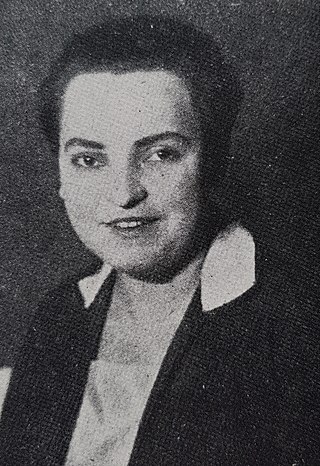
Selma "Selli" Engler was a leading activist of the lesbian movement in Berlin from about 1924 to 1931.
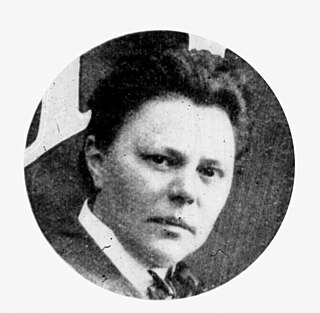
Johanna Elberskirchen was a feminist writer and activist for the rights of women, gays and lesbians as well as blue-collar workers. She published books on women's sexuality and health among other topics. Her last known public appearance was in 1930 in Vienna, where she gave a talk at a conference organised by the World League for Sexual Reform. She was open about her own homosexuality which made her a somewhat exceptional figure in the feminist movement of her time. Her career as an activist was ended in 1933, when the Nazi Party rose to power. There is no public record of a funeral but witnesses report that Elberskirchen's urn was secretly put into the grave of Hildegard Moniac, who had been her life partner.

Agnes Bluhm was a German physician, eugenicist, and winner of a Goethe medal. She believed that German women could improve the race using eugenics and forced sterilisation. She wrote that the "female psyche" made her gender predisposed towards working for "racial hygiene".

Anne-Marie Durand-Wever was a German gynaecologist and co-founder of Pro Familia, the German branch of the International Planned Parenthood Federation.

Mentona Moser was a Swiss social worker, communist functionary and writer. Born into wealth, she disapproved of high society, and became involved in philanthropic work, helping to launch the Swiss Communist Party and one of the first birth control clinics in Zürich.

Fanny Moser was a Swiss noblewoman who at one point was the richest woman in Eastern Europe. She was one of the five women evaluated in Freud's Studies on Hysteria, which led to his psychoanalytic theories.
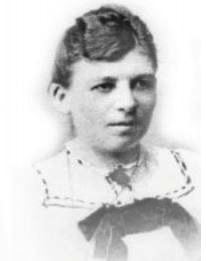
Emma Trosse was a German teacher and school administrator. Trained as a teacher and later passing an examination to be a principal, Trosse began her career working in public schools and as a private tutor. In 1895, she published one of the first scientific works on homosexuality and advocated for legal protections for homosexuals. She was the first known woman to scientifically discuss lesbianism. She also published books analyzing ancient medical practices in medieval Europe, and among the Greeks and Egyptians. After her marriage, she became a clinician in her husband's diabetes clinic, and began writing literature on diabetes.

Jenny Thomann-Koller was a gynecologist, pediatrician, and Head of Internal Medicine at the Schweizerische Pflegerinnenschule mit Spital in Zurich. In her dissertation, Beitrag zur Erblichkeitsstatistik der Geisteskranken im Ct. Zürich. Vergleichung derselben mit der erblichen Belastung gesunder Menschen u. dergl., published in 1895, she introduced a control group which challenged the then-popular theory of degeneration and eugenics.
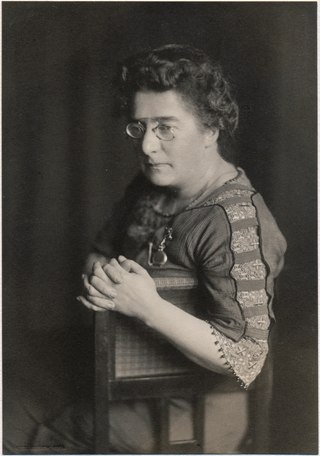
Adeline Rittershaus was a German philologist, a scholar in old Scandinavian literature, and champion for the equality of women. She earned her doctorate in 1898, at the University of Zurich, being one of the first women to do so at that institution, and acquired in 1902, as the first woman, a Venia legendi at the Faculty of Arts of the same university. Her most famous work is a collection of Icelandic folk tales.

Ida Bindschedler was a Swiss children's writer.

Esther Fischer-Homberger was a Swiss psychiatrist and medical historian. Her research focused on the history of psychiatry, psychosomatics and forensic medicine as well as the medical history of women.

Elisabeth Hermine Winterhalter was a German gynecologist, surgeon, feminist and patron of the arts. She was one of the first female doctors and the first female surgeon in Germany. The painter, Ottilie Roederstein, was her long-time companion.
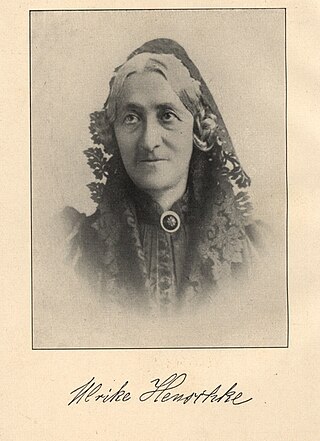
Ulrike Henschke was a German women's rights activist, advocate of secondary and vocational education for women and founder of the Victoria Continuation School, a technical college for women. She was also an accomplished author, including writing the novel Gertrud von Stein under the pseudonym Clara Ulrici.

Ella Mensch was a German writer, journalist, teacher, feminist and editor. In 1886 she became one of the first German women to earn a doctorate in German Literature from the University of Zurich along with Marie Nowack. She was associated with the German Female Teacher's Association. She also served as the editor of a women's magazine, Frauen-Rundschau.
References
- 1 2 3 4 5 6 Creese 2004, p. 138.
- ↑ Schmid 2003, p. 83.
- 1 2 3 4 5 Institute for the History of Medicine 2015.
- ↑ Albisetti 1982, p. 104.
- ↑ Schmid 2003, pp. 83–84.
- ↑ Hoesch 1995, p. 375.
- 1 2 3 Creese 2004, p. 139.
- ↑ Forbes & Keith 1914, p. 263.
- ↑ Mann 1906, p. 395.
- ↑ Willdenow 1898, p. 523.
- ↑ Leidinger 2008, p. 67-68.
- ↑ Schnurrenberger & Winter 2002.
- ↑ Albisetti 1982, p. 120.
Bibliography
- Albisetti, James C. (1982). "The fight for female physicians in Imperial Germany" (PDF). Central European History . Cambridge, England: Cambridge University Press. 15 (2): 99–123. doi:10.1017/S0008938900010542. ISSN 0008-9389. PMID 11614326. S2CID 34051784 . Retrieved 3 June 2017.
- Creese, Mary R. S. (2004). Ladies in the Laboratory II: West European Women in Science, 1800-1900: a Survey of Their Contributions to Research. Lanham, Maryland: Scarecrow Press. ISBN 978-0-8108-4979-2.
- Forbes, Ernest Browning; Keith, M. Helen (1914). A Review of the Literature of Phosphorus Compounds in Animal Metabolism. Ohio Agricultural Experiment Station Technical Series. Vol. Bulletin #5. Wooster, Ohio: The Agricultural Commission of Ohio. OCLC 38253064.
- Hoesch, Kristin (1995). "Die Bemühungen in Deutschland tätiger Ärztinnen um die Approbation von 1877–1900". Medizinhistorisches Journal (in German). Stuttgart, Germany: Franz Steiner Verlag. 30 (4): 353–376. ISSN 0025-8431. JSTOR 25805142. PMID 11630257.
- Leidinger, Christiane (2008). Keine Tochter aus gutem Hause: Johanna Elberskirchen (1864-1943) (in German). Konstanz, Germany: UVK Verlagsgesellschaft. ISBN 978-3-86764-064-0.
- Mann, Gustav (1906). Chemistry of the proteids. London, England: Macmillan and Company. OCLC 5315611.
- Schmid, Holger (2003). Briefe von und an Friedrich Nietzsche, Januar 1885 - Dezember 1886 (in German). Berlin, Germany: Walter de Gruyter. ISBN 978-3-11-017428-1.
- Schnurrenberger, Regula; Winter, Anita (2002). "Mentona Moser (1874-1971), Clara Willdenow (1856-1931), Pauline Bindschedler (1856-1933) [online]". Lesbengeschichte. Zürich, Switzerland: Boxhammer, Ingeborg/Leidinger, Christiane. Archived from the original on 8 March 2016. Retrieved 3 June 2017. self-published but with references.
{{cite web}}: CS1 maint: postscript (link) - Willdenow, Clara (1898). "Ueber Lysursäure und ihre Salze" [About lysuric acid and its salts]. Zeitschrift für Physiologische Chemie (in German). Berlin, Germany: Walter de Gruyter. 25 (5–6): 523–550. doi:10.1515/bchm2.1898.25.5-6.523. ISSN 0018-4888. Archived from the original on 19 February 2018. Retrieved 3 June 2017.
- "Clara Willdenow". Geschichte Charité Berlin (in German). Berlin, Germany: Institut für Geschichte der Medizin und für Ethik in der Medizin, Charité. 2015. Archived from the original on 3 June 2017. Retrieved 3 June 2017.